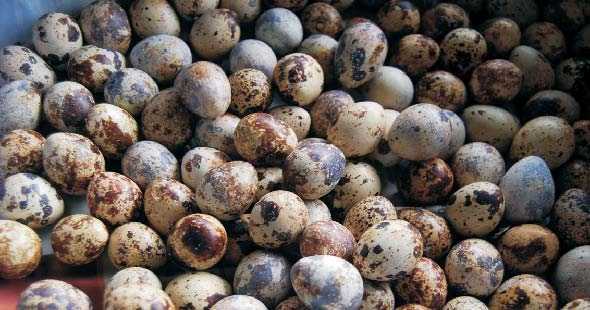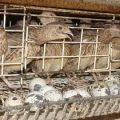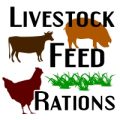Quails (Coturnix coturnix) are small birds that have been around in the country for quite some time now. This small (17 cm on average) plump breed usually comes in hues of brown, black, and grey with white streaks. They are fairly agile animals – so much so that smaller cages are more appropriate for them to avoid injuries. Previously known only as hunting or game birds, quails (also known as pugo in the Philippines) have now come to the forefront of the poultry industry due to the high demand not only for its meat, but also for its high-nutrient eggs (itlog ng pugo).

Quail farming has been increasing in popularity as this breed is also considered a possible solution for the growing demand in poultry products. Quail egg production heavily relies on the hen’s nutrition; thus, making the feeding management very important in quality egg production. Despite the increasing demand for quail meat and egg, less investors venture into quail production as very little is known about raising this breed. Unknown to many, quail is relatively easier to raise compared with chicken as they require less nurturing because they are not susceptible to common poultry diseases, their cages entail less space, and they could be fed with cheaper organic compounds as in the study of Dr. Feliciano R. Bejar of the Samar State College of Agriculture and Forestry (SSCAF).
What makes up quail feeds?
In order to produce quality quail eggs that maintain high nutritional value and egg shell strength for higher and faster return of investment, feed content and management of quails should be closely monitored. Chicken feed content and management are largely different from that of quail, for example, the protein requirements vary for both at different stages of growth. Using chicken feeds for quails result to inefficient layers and even higher mortality rates as the quails’ necessities are not met. A carefully studied and balanced diet for a quail feed needs to be comprised of ingredients that provide the correct amount of protein, calcium, phosphorus, and methionine at a given growth stage. Yellow corn, rice bran, fish meal, soybean meal, copra meal, dicaphos, limestone, lysine, DL methionine, oil, vitamin premix (vitamin A, E, D3, K, riboflavin, pantothenate, niacin, pyridoxine, B12 and choline), minerals (manganous sulfate, zinc oxide, ferrous sulfate, copper sulfate and oyster shell) and salt are the usual ingredients mixed together to create a suitable feed for raising quails. Mashed or crumbled feeds are sold commercially, with prices ranging from 800Php-1200Php per sack.
A BAR-funded research
In a recent study of a SSCAF-based instructor, Dr Feliciano R. Bejar, organic ingredients were induced to both the meal and drinking water of quails with aim to improve growth, production performance, and egg qualities of quail. Dr. Bejar uses Trichanthera gigantea Nees. (T. gigantea) leaf, aloe vera extract, and acid cheese whey to achieve better quality quail products at low cost. With the financial assistance granted from the Department of Agriculture – Bureau of Agricultural Research (DA-BAR) Thesis/Dissertation Assistance Program, Dr Bejar discovered how cheap organic materials could positively affect the production of quails and its eggs that could help fill the high market demand and encourage more investors into quail farming.
DA-BAR opens its grant to all members of the National Research and Development System in Agriculture and Fisheries (NaRDSAF), such as members of the agriculture and fisheries research and development (R&D) systems, and local government units (LGUs), with financial support of up to 50,000Php, delivered in two installments (90 percent upon signing of contract, and the remaining 10% upon delivery of accomplished thesis/dissertation hard copy).
What are T. gigantean, aloe vera, and acid cheese whey?
In Dr. Bejar’s study, he added T. gigantean leaves, and aloe vera extract and acid cheese whey to quails’ feed and drinking water, respectively. He considered the quails’ growth performance, laying performance, egg qualities, and project viability as determining factors of the positive effects of these three components to quail performance and productivity.
T. gigantea is a shrub native to the swampy areas of Latin America, but has adapted to the Philippines as it grows well in local tropical conditions. Used mainly as forage, living fence, and shade tree, it has now being used also as feed to produce organic pigs and chicken in the country. T. gigantea possesses medicinal values as it was used by Columbians to treat nephritis in humans. It contains high water soluble carbohydrate compared to other fodder trees. Its nutrient components include crude protein, water soluble protein, water soluble carbohydrates, starch, total sugars, reducing sugars, lignocelluloses, ether extract, among others. T. gigantea was added to the other ingredients of the feed at 0, 15, and 25 percent, respectively, in both grower and layer mash.
On the other hand, additives to quails’ drinking water were aloe vera extract and acid cheese whey.
Aloe vera extract is widely known as an anti-inflammatory for minor skin infections and natural remedy to hair loss problems in men and women, as compounds such as polysaccharides, mannans, anthraquinones and lectins are present. A specie of a succulent plant and believed to have originated in Sudan, aloe vera flourishes in dry countries like Africa, India, and Nepal. Orally or topically administered for wounds, aloe vera extends this therapeutic effect to animals. In a previous study in 2005 by the same author, it was found that supplementation of aloe vera extract to broilers resulted to positive growth response and high performance.
Another additive to the quails’ drinking water was acid cheese whey. After coagulation and removal of curd, what remains is the water portion of the milk known as cheese whey. The two types of whey are sweet and acid, where the first is produced during the creation of rennet-type cheese and the latter during production of acid-type cheese. Acid cheese whey contained lactic acid bacteria and was considered probiotic – these are live enhancers of intestinal microbial balance.
Organic components and quail and egg production
T. gigantea, aloe vera extracts, and acid cheese whey were added to 300 13-day old quails’ meal and drinking water in a four-month experiment performed at the Northwest Samar State University, San Jorge Campus in Samar. Cages for brooding and growing were constructed at the University for the experimental birds. T. gigantea meals of 0, 15, and 25% were fed to quails, simultaneously were served with drinking water incorporated with aloe vera at levels 0, 15, and 25 mL throughout the growing and laying stages, and acid cheese whey (same levels) throughout the experimental period.
Dr Bejar’s study showed that 15% of T. gigantea meals with simultaneous additives of aloe vera extract and acid cheese whey ultimately contributed to positive and increased growth response, laying performance, qualities of eggs, and project profitability. Quail eggs produced were longer and wider, with thicker shells and larger surface areas and increased breaking strength, which makes for sturdier transport during dissemination of egg products. Results of higher net income and return of investment is attributed to the positive effects to both the quails and their eggs. Above all, application of these three components enabled for the lowered cholesterol content of the egg yolks that makes pugo all the more nutritious and healthy, and in turn, make these little birds a big hit for an even bigger market.
This article was based on the study, “Growth and Reproductive Performance of Quail Fed with Varying Levels of Trichanthera Gigantea Nees. Leaf Meal Supplemented with Aloe Vera Extract and Acid Cheese Whey in Drinking Water,” by Feliciano R. Bejar of the Samar State College of Agriculture and Forestry, San Jorge, Samar.
For more details on the DA-BAR Thesis/Dissertation Program, please contact the Institutional Development Section, Program Development Division of the Bureau of Agricultural Research at RDMIC Bldg., Visayas Avenue corner Elliptical Road, Diliman Quezon City. Trunklines: (02) 928-8624 and (02) 928-8505; or email us at pdd-ids@bar.gov.ph
References:
1. “Trichanthera gigantean” (n.d.). Retrieved from the Tropical Forages. http://www.tropicalforages.info/key/Forages/Media/Html/Trichanthera_gigantea.htm
Source: Zuellen B. Reynoso, Bar Chronicle July 2011 Issue (Vol. 12 No. 7)







many thanks for these very important and useful infos..
WITH 700 PULLETS AND STARTED INCREASING LAYING EGGS..EXCITING!